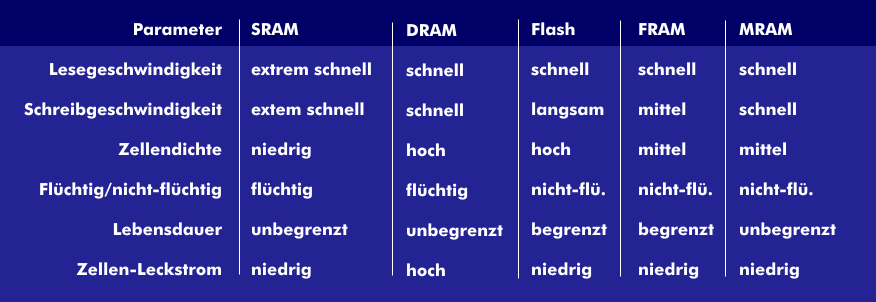random access memory (RAM)
A random access memory(RAM) is a volatile memory that was discovered and patented by Robert Dennard in 1968. The first RAM had 16 pins, a clock frequency of 4.7 MHz and an access time of 200 ns.
Incomputers, RAMs are used by central processing units( CPU) as working memory or main memory, which they can access randomly. This means that each byte can be accessed directly without the previous or following byte having any reference to it. Data is stored in a RAM until it is overwritten by new data and for as long as the RAM is supplied by a supply voltage. The access times of RAMs are in the nanosecond range.
The many years of RAM development have resulted in static and dynamic RAMs, Static RAMs( SRAM) and Dynamic RAMs( DRAM), synchronous and asynchronous RAMs, Synchronous Dynamic RAMs( SDRAM) and Async. SRAMs, have emerged. But also RAMs that use clock cycles multiple times by means of Single Data Rate( SDR), Double Data Rate( DDR) and Quad Data Rate( QDR), that accelerate access speeds like Extended Data Output DRAMs ( EDO-DRAM) or Burst Extended Data Output DRAMs( BEDO-DRAM), that are based on a different bus architecture like Rambus DRAMs( RDRAM), and finally those that shorten latency times like Reduced Latency DRAMs ( RLDRAM).
Furthermore, RAM devices have been developed on resistive, magneto-resistive and ferroelectric basis: Resistive RAM( RRAM), Magneto-resistiveRAM( MRAM), Ferro RAM( FRAM) and Ferroelectric Transistor RAM( FeTRAM).
A key aspect for the use of RAMs, especially in notebooks, tablets, smartphones and other mobile devices, is their power dissipation, which increases as the square of the supply voltage. For this reason, the trend is toward lower supply voltages, which is now as low as 1.2 V for Extreme Data Rate DRAM( XDR DRAM).

